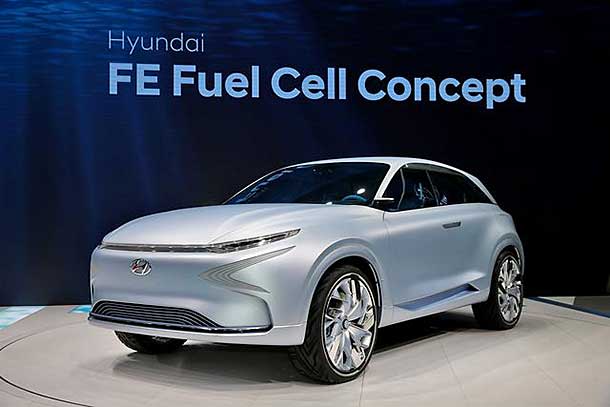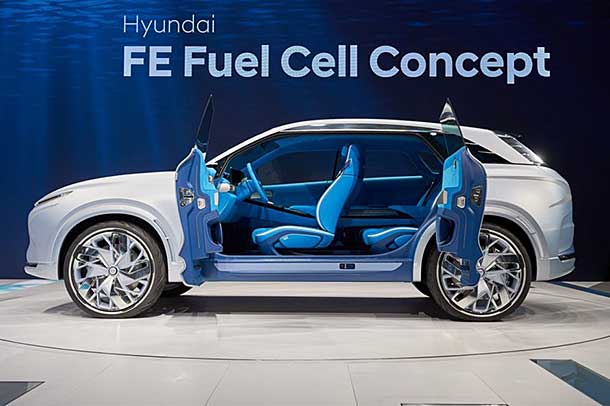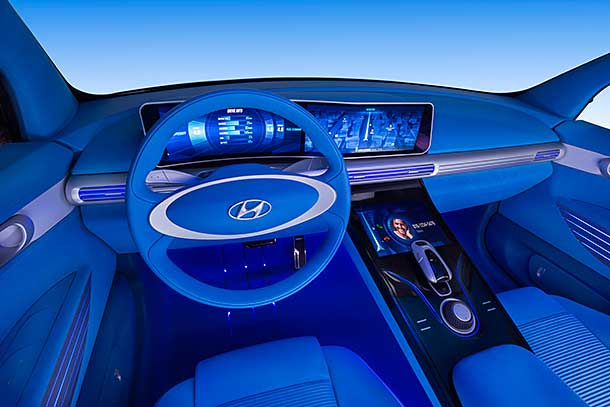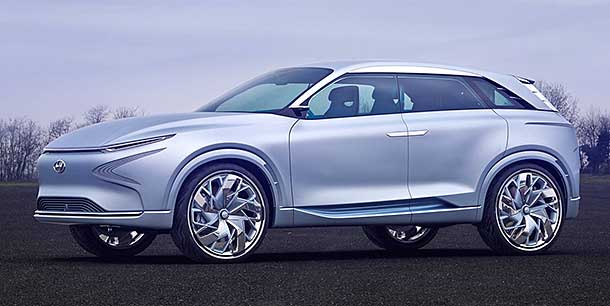Hyundai FE Fuel Cell Concept

At the 87th Geneva Motor Show held from March 9 to March 19, 2017, South Korea-based automaker, Hyundai, unveiled the next generation FE (Fuel Eco) Fuel Cell Concept, a sturdy-looking hydrogen-powered vehicle to be the successor to the Hyundai Tucson Fuel Cell.
The idea of an SUV or CUV that runs with hydrogen power has long been heard from the auto manufacturer. A CUV or Crossover is a combination of a sports utility vehicle and a passenger vehicle. As opposed to light trucks that use the body-on-frame platform, CUVs are built on a car platform.
The FE Fuel Cell Concept, the fourth generation of its kind, is the manufacturer’s contribution to how vehicles will be powered in the future. It is included in the list of 14 new models to be introduced by the year 2020 while there will be 22 fuel alternative cars all-in-all. This new breed of vehicles is the company’s next step to building a zero-emission Hydrogen Energy Society. These “eco cars” will include four plug-in hybrids, five hybrids, four electric cars and just recently launched FE fuel-cell vehicle.
There are three highlights to the FE Fuel Cell Concept:
- It is hydrogen-powered and can run up to 497 miles with just one fill.
- The design has been inspired by nature and water, thus the flowing and clean concept.
- The elements of the concept will be incorporated with the new model to be launched in 2018.

The Radical Design
As for the looks, the vehicle boasts clean and flowing lines that exude robustness and elegance. The wheels will be large and pushed to the corner and are aerodynamic for better handling. The new design has been inspired by water and coincidentally, the only element the FE Fuel Cell Concept will be emitting once it gets on the road. It will have headlamps and efficient LED tail lamps strategically located at the rear of the vehicle.
However, the hood looks a tad bulky and the design of the grille unique and clean, with just the typical logo in front and is devoid of the typical headlights found in other SUVs or CUVs, for that matter. Conversely, the interior will come with a screen with analogue dials as well as an infotainment screen. Moreover, a gear shifter screen will be added which can be connected to a smartphone.
The designers tried to achieve a minimalistic look and they did not disappoint. Apart from the lines and contours of the body that were aerodynamically built, a spoiler has been integrated on the liftgate and vents were also added strategically to cool down the heat.
The Interior
The cabin can seat four, with individual seats. This set-up offers more legroom. Meanwhile, there is a main dashboard, that is, of course, digital. It displays navigation information that reaches to the center of the panel while a secondary display is integrated in the console that serves as infotainment. Another interesting feature in the interior is the internal air humidifier that is capable of recycling water emissions present in the atmosphere inside the cabin. It also circulates fresh air inside the vehicle. The trunk is big enough to accommodate a mini electric scooter and has a built-in charger for the mobility device to ensure there is always an extra mile of distance in case hydrogen needs to be refilled and the next station is not in sight. The Hyundai Company has everything figured out, including battery packs designed for portability. This is why these accessories have been added to ensure passengers in the car are continuously plugged-in and there is enough juice for smartphones and devices.

Fuel Cell
The Fuel Cell Concept’s main feature is its hydrogen cell technology. This is in line with what Vice Chairman Woong Chul Yang of Hyundai Motor Company mentioned about the significant evolution of the car manufacturer’s pioneering leadership in terms of the new technology in terms of car power. In fact, hydrogen fuel cell technology is not new to Hyundai since the FE concept is already the fourth generation model, with the Hyundai Tucson Fuel Cell as its predecessor. Also, as opposed to the Gen II system that is applied in Tucson ix30 Fuel Cell SUV, the fuel cell that comes with the concept is more efficient and lighter, at 10 percent and 20 percent, respectively. In terms of range, the power density of the fuel stack has been increased to 30 percent which makes it capable to cover more miles than the earlier Tucson.
Smart Sense Technology
Hyundai has introduced an intelligent safety technology brand known as “Smart Sense” and the FE Fuel Cell Concept will also have this feature. This includes several technologies to ensure safety such as, Lane Keeping Assist System (LKAS), ABSD and AEB.
Pros and Cons
The Hyundai FE Fuel Cell Concept has numerous features that are appealing and promising. First, it can run longer distances as opposed to electric cars since it can cover around 500 miles with just a single hydrogen fill. The fuel cell is also more efficient and powerful compared to that of the Tucson ix30 Fuel Cell SUV. The body design is aerodynamic and has a fresh look. It is also safe for the environment since it will have zero-carbon emission with water being the only element it will emit.
While critics say that the construction of hydrogen fueling infrastructure can be a challenge and producing hydrogen can be expensive, the cost of production is coming down. Consequently, the price of hydrogen will be cheaper. Moreover, the costs of hydrogen-powered vehicles are also high and the average car owner might not be able to afford it. However, savings will be enjoyed in the long run.

Final Thoughts
The Hyundai FE Fuel Cell Concept is more powerful and efficient than its predecessor when it comes to hardware and is environment friendly. It also keeps up with the trend in technology in terms of design and features. With Hyundai Motor Company being the first to come up with a mass-produced vehicle in 2013 and announcing the 14 new models by 2020, there is no doubt that the car manufacturer is focused on maintaining its status as a pioneer in hydrogen fuel cell technology.
References
http://www.digitaltrends.com/cars/hyundai-fe-fuel-cell-concept/
http://magazine.fev.com/en/integration-fuel-cell-range-extender-subcompact-category-vehicle/
http://www.autoblog.com/2017/03/07/hyundai-fe-fuel-cell-concept-hydrogen-suv-geneva/
http://www.motortrend.com/news/hyundai-fe-fuel-cell-concept-previews-497-mile-hydrogen-suv/